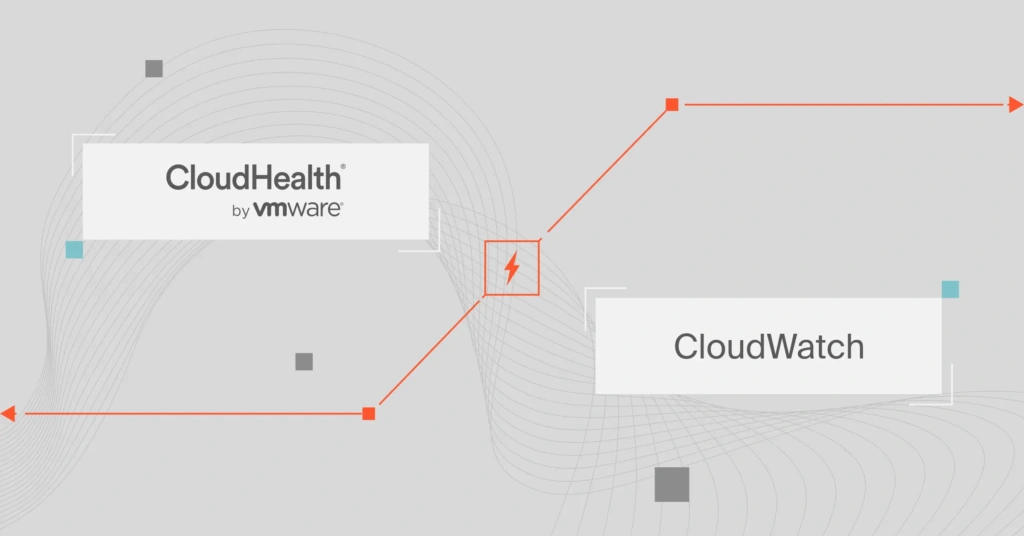Amazon’s CloudHealth and VMware’s CloudHealth are two of the most popular cloud management and system monitoring platforms today. But which platform does what, and are they even direct competitors?
In this post, we’ll compare the two services and highlight their main differences so you can choose which to use — or whether to use both.
Table of Contents:
What Is CloudHealth?
VMware’s Aria Cost powered by CloudHealth is an enterprise cloud financial management platform with added cloud management features, like security and governance.
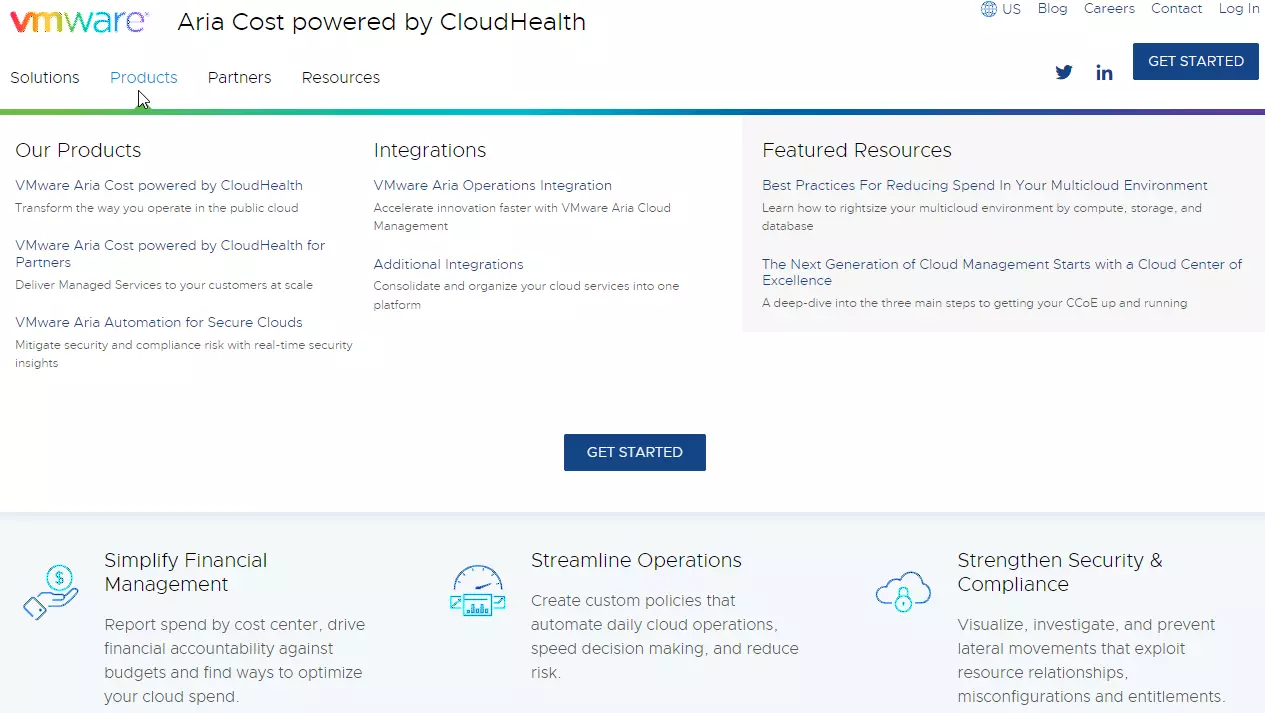
Credit: VMware Aria Cost powered by CloudHealth features
The CloudHealth platform ingests massive amounts of data from multiple sources and integrations. It then aggregates the data in one place, enabling simpler analysis and quicker decision-making. This helps IT staff to visualize, analyze, and act on their environment’s resource usage, application/infrastructure performance, security, and compliance aspects.
CloudHealth main features: Why is CloudHealth so popular?
CloudHealth main capabilities revolve around helping FinOps, DevOps, and DevSecOps teams discover and continuously monitor their cloud or on-premises environments. Here’s more:
Cloud financial management
CloudHealth offers several cloud cost management features to consider:
- Visualize your cloud costs and usage
- Supports chargebacks and showbacks by department, team, project or application
- Create custom budgets and track your spending against them
- Manage commitment based discounts, such as Reserved Instances (RIs) and Savings Plans, through amortization, purchase modeling, and optimizations
- Get custom rightsizing recommendations you can implement manually
- Includes budgeting and forecasting support with cost anomaly detection and alerts
- Create custom policies to automate cost control
- Facilitate collaborate in cloud cost management from a single place
Check this out:
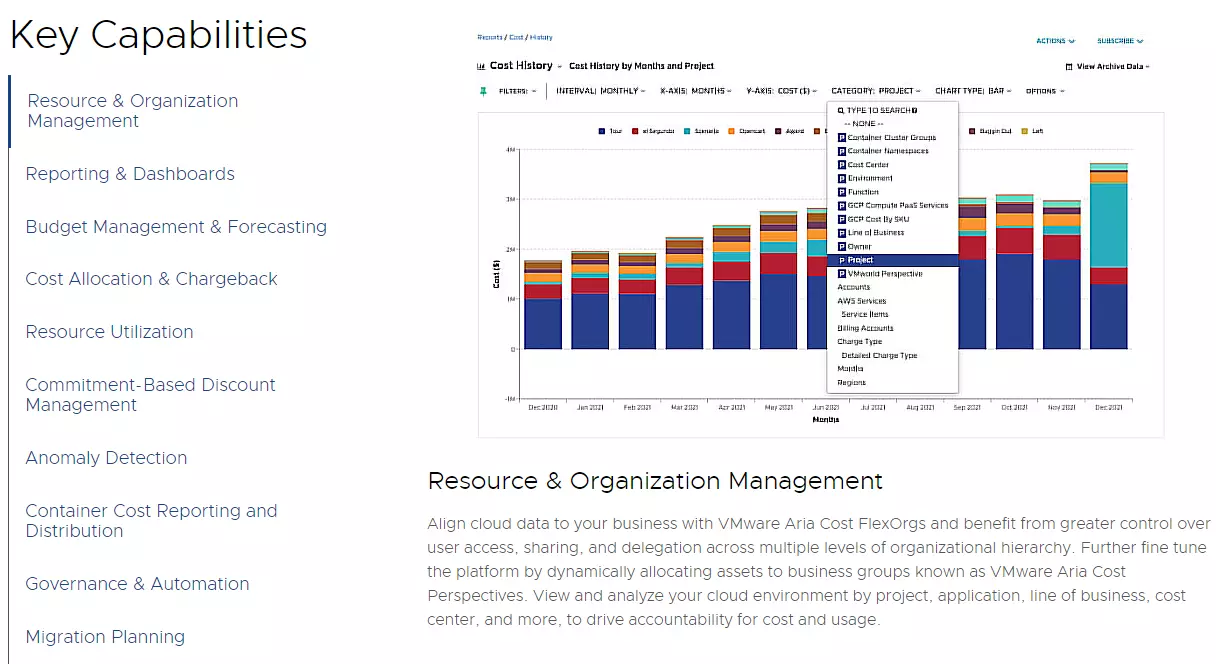
Credit: CloudHealth cloud financial management features
Cloud governance with Cloud Operations
Cloud Operations enables you to create custom policies to automate cost management, security concerns, and more. It works for public, private, hybrid cloud, and multicloud deployments — as well as containerized environments.
The tool enables you to contrast performance data with your provisioned capacity to pinpoint assets that you could scale down or terminate to reduce unnecessary spending.
You’ll get alerts when conditions diverge from your desired state. Fortunately, your custom policies can kick in immediately and start enabling automated actions that execute changes in your environment.
Compliance and security management:
The platform supports real-time anomaly detection and leverages automation and machine learning to catch security concerns. For example, VMware Aria Automation for Secure Clouds detects misalignments, lateral resource relationships, entitlements, and more. Check this out:
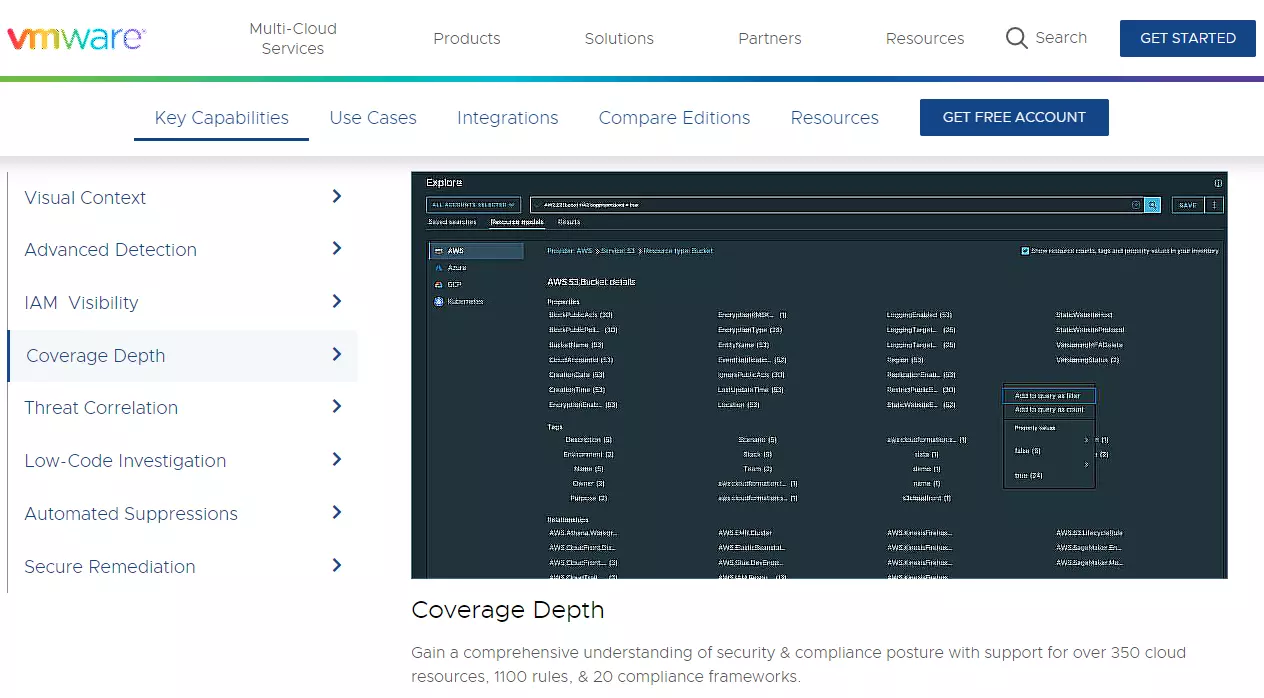
VMware Aria Cost powered by CloudHealth pros
- Works for cloud and on-premises deployments
- Supports hybrid cloud and multi-cloud cloud cost monitoring and management
- Automates some cloud operations
- Supports security monitoring and management within one platform
VMware Aria Cost powered by CloudHealth cons
- Ideal for enterprises looking for traditional cloud cost management features; not suitable for smaller organizations
- Limits granularity to just department, project, team, and application
- Doesn’t automatically implement risghtsizing recommendations
What Is Amazon CloudWatch?
Amazon CloudWatch is a monitoring and cloud management platform integrated into the Amazon Web Services (AWS) environment. Yet, you can use it for on-premises and hybrid cloud deployments. AWS designed CloudWatch for developers, IT managers, DevOps engineers, and site reliability engineers (SREs).
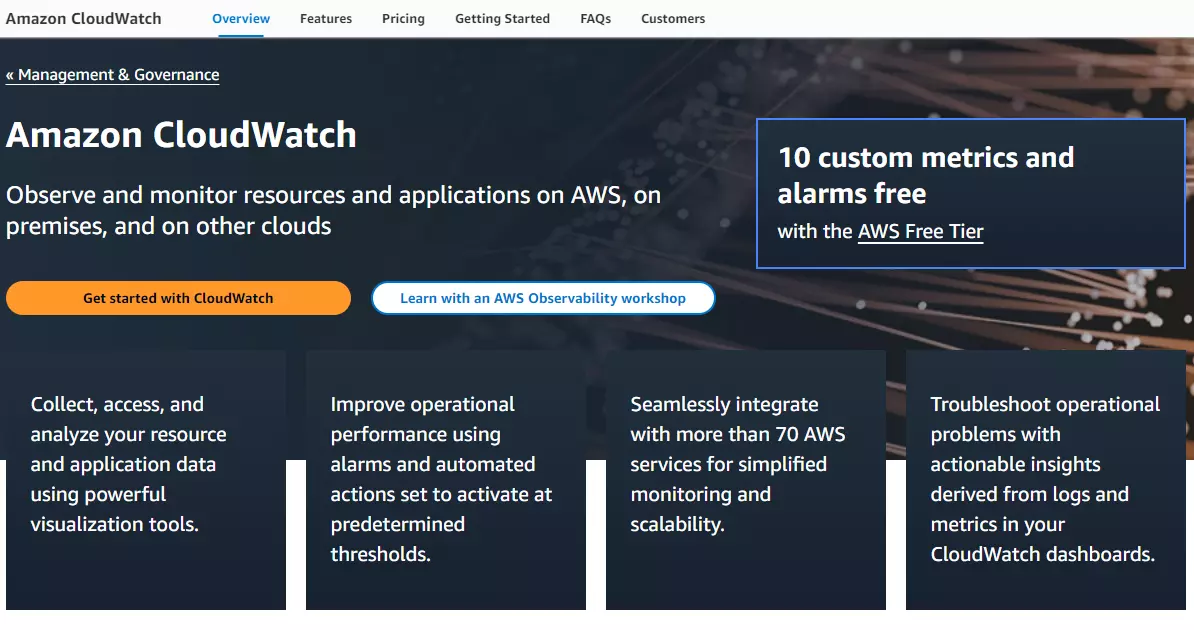
CloudWatch main features: Why should you use Amazon CloudWatch?
With CloudWatch, you can collect, visualize, track, analyze, and act on operational and performance data. It uses logs, metrics, and events from services, applications, and other resources deployed on the AWS platform or on-premises servers to achieve this.

There’s more.
Cloud operations monitoring
- Collect application and infrastructure metrics and logs from across 70 AWS services, including custom ones to enable fine-grained monitoring and troubleshooting
- Also collect, aggregate, and analyze container logs and metrics all in the same place
- Create ongoing, near-real-time metrics streams for any destination you want
- Supports monitoring and troubleshooting across multiple accounts within an AWS Region
- Create custom and reusable graphs to view your cloud resources and services in a unified dashboard
- Configure dynamic, custom alarms for anomalous behavior and specify when to trigger an automatic action
- Correlate logs and metrics to pinpoint root causes faster
- Supports Internet, RUM, synthetics, and Lambda monitoring
- Link with Auto Scaling to support automated actions such as scaling down the number of instances during low usage periods to optimize costs
- Set CloudWatch logs and metrics to automate actions on other AWS services such as Amazon EKS and ECS – and even Kubernetes clusters
- Fine-tune resource usage with up to 15 months’ worth of data

Credit: CloudWatch architecture
CloudWatch’s Compliance and security management features
As with other AWS services, Amazon CloudWatch supports AWS Identity and Access Management (IAM) by default. This helps you control what resources and who has access to your data.
The platform is also FedRamp and PCI compliant. It encrypts data at rest and in transit. To further boost compliance and security, you can also encrypt your log groups with AWS Key Management Service (AWS KMS).
CloudWatch also enables you to define custom data protection policies. This helps you scan logs during ingest, determining how much sensitive data they hold and mask it. Your security engineers can unmask it for validation provided they have elevated IAM privileges.
CloudWatch pros
- Collects in-depth application and operations metrics and logs
- Native integrations with services such as Amazon CloudTrail, you can pinpoint root causes of issues, leading to quicker troubleshooting and recovery
- Integrates natively with over 70 AWS services and works across AWS accounts in an AWS Region
- Delivers on-premises, hybrid cloud, and other cloud application monitoring needs
- Supports automation with custom policies
- Includes IAM security and compliance management capabilities
CloudWatch cons
- Requires integration with another service (Amazon Cost Explorer) to deliver cloud cost management insights specifically — rather than operations-focused metrics and logs
- May require advanced data analytics skills to beat overwhelm and make sense of its data
- Can be costlier than third-party monitoring tools
- Some standard AWS metrics can’t be seen in intervals shorter than one minute
- Most advanced integrations are limited to AWS services
So, we’ve explained what Amazon CloudWatch and VMware Aria Cost powered by CloudHealth are and do. In this next section, we’ll share a quick rundown of how they differ.
What Are The Major Differences Between CloudHealth And CloudWatch? (Comparison Chart)
Here’s a handy comparison table to help you quickly compare CloudHealth and CloudWatch side-by-side.
Amazon CloudWatch | VMware Aria Cost powered by CloudHealth | |
Description | Management and monitoring platform that reports performance and applications data across a variety of organizational sizes | Cloud financial management, security, and governance platform for enterprises |
Delivery type | Infrastructure-as-a-Service (IaaS) | Software-as-a-Service (SaaS) |
Deployment | Public, private, and hybrid clouds, as well as on-premises and other cloud applications | Public, private, and hybrid clouds, as well as on-premises |
Cloud management | Supports dynamic, custom policies to trigger and automate management actions, such as alarms | Also supports dynamic, custom policies to trigger and automate management actions, such as alarms. However, automations here can execute changes in your environment |
Uses metrics, logs and events for infrastructure, application, and container monitoring
Offers real-time insights with Metrics Streams | Uses metrics and logs for application, infrastructure, and container monitoring Supports real-time insights, too | |
Security tools and compliance solutions | Offers IAM and custom policies for access control
PCI and FedRamp compliant | Offers custom policies for access control
KSPM, CSPM, Threat Correlation, and CIEM solutions |
Integrations | Native integration with over 70 AWS services, including Amazon EC2 Auto Scaling and Amazon SNS
Supports third-party integrations via API and webhook | Integrates with various third-party tools via webhook or API |
Table: A side-by-side comparison of CloudHealth vs Amazon CloudWatch
Both CloudHealth and CloudWatch deliver enterprise-grade monitoring and management solutions. The biggest difference between them is that while CloudHealth emphasizes financial management in the cloud, CloudWatch is more concerned with monitoring environments for operational insights.
That means that with CloudWatch, you may need to use an additional integration, such as Amazon Cost Explorer or AWS Cost and Usage Report to correlate and interpret your metrics, logs, and events in terms of the cost of resources used.
CloudHealth organizes its data to link directly to cost management, such as the department, team, app, or project that’s consuming resources. But it may be limited in terms of pinpointing operational concerns compared to CloudWatch.
Pricing differences between CloudWatch vs CloudHealth
Amazon CloudWatch pricing depends on whether you use the free or paid tier. The Free tier includes:
- Free tools that are always available and do not have any limitations
- Tools that are free for 12 months from the date of activation
- Trials for testing specific tools for a short period of time
Check this out:
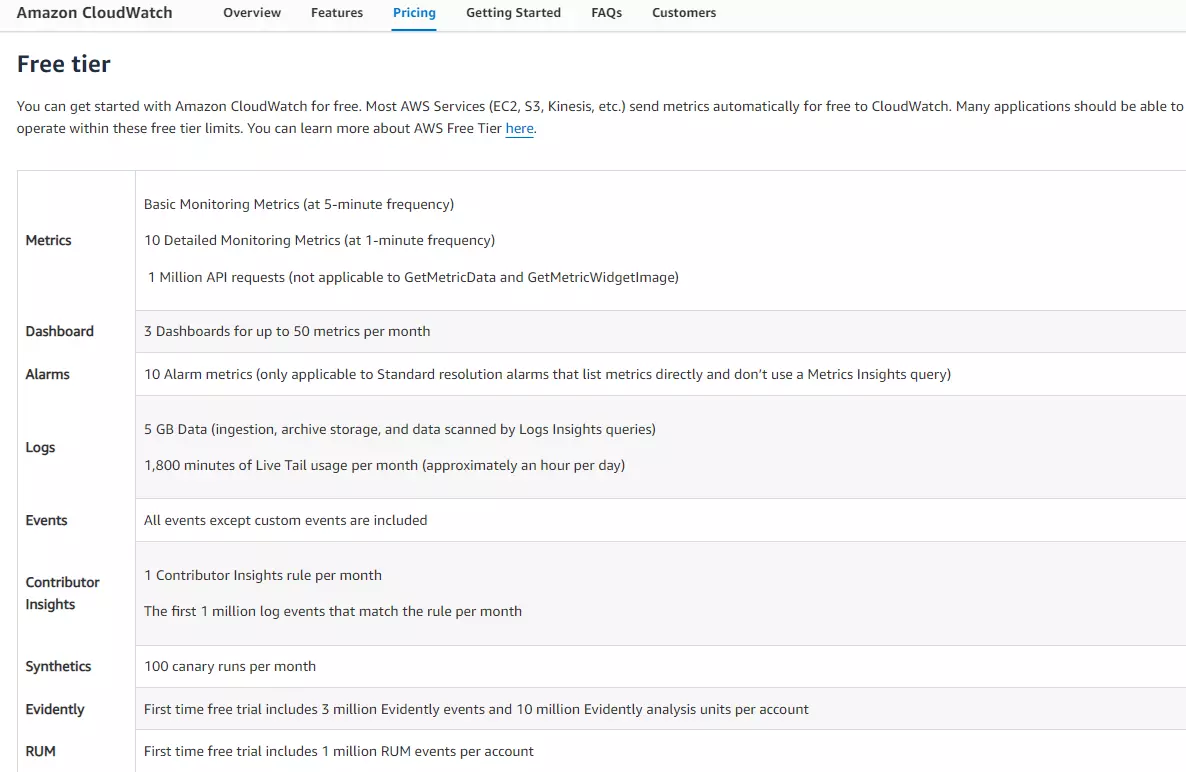
If you want more and advanced CloudWatch monitoring and management capabilities, you’ll need to pay up. Yet, CloudWatch pricing can be quite complex.
There are several factors that determine your CloudWatch costs. That includes the volume of metrics, logs, and events, as well as the type of dashboards, alarms, canaries, contributor/metric/internet insights, and cross-account observability you choose.
Check out our more in-depth Amazon CloudWatch pricing guide here for a dedicated breakdown.
Pricing for CloudHealth is more straightforward.
However, CloudHealth pricing varies depending on what services you use, such as Secure Clouds, Cloud Operations, or CloudHealth for AWS.
Take the pricing for VMware Aria Cost for CloudHealth for AWS, for example. Currently, CloudHealth for AWS charges a flat fee of $45,000 (12 months), $90,000 (24 months), and $118,8100 (36 months) to manage up to $150,000 in AWS spend, according to AWS Marketplace. There’s a $0.03/unit per month for overages. Consider this:
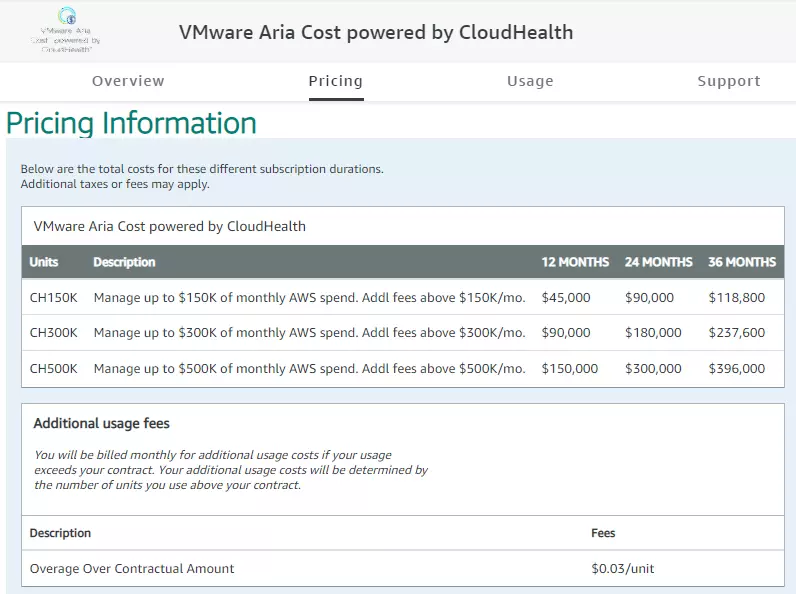
When To Use VMware Aria Cost Powered By CloudHealth
Choose CloudHealth when you want a SaaS cloud financial management platform with more traditional cost management and monitoring capabilities. Those include tailored resource right sizing recommendations, cost management automations based on custom policies, and committed discount management.
When To Use Amazon CloudWatch
Choose CloudWatch when you want to collect, analyze, and act on more detailed infrastructure and application performance and security data. The platform is part of the AWS IaaS offering, so while it offers more customizability, you’ll have to do a lot more work to get actionable insights, especially for cloud cost optimization.
How To Understand, Control, And Optimize Your Cloud Costs With CloudZero
But if you need more immediately actionable cloud cost insights, CloudZero can help. Unlike CloudWatch and CloudHealth, CloudZero delivers beyond mere overviews like average and total costs.
Instead, CloudZero provides you with contextual cost intelligence broken down into unit costs, such as:
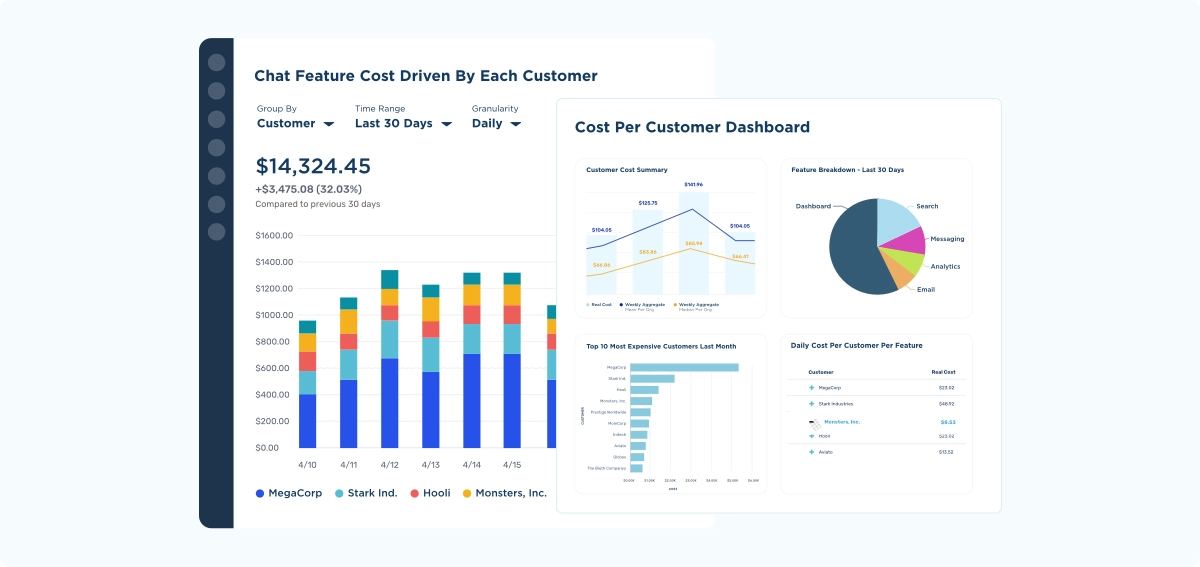
- Cost per individual customer so you can set profitable pricing for your services based on each customer’s usage. No cost allocation tags required.
- Get the complete picture. View your costs of tagged, untagged, and untaggable resources — as well as individual tenant costs in multi-tenant environments
- Cost per product feature, helping you identify which software features are most popular, or expensive to maintain, and which ones to decommission, repurpose, or charge for based on usage or popularity.
- Cost per project, team, or product so you can pinpoint where to cut costs or increase investment to get better returns
- Cost of goods sold (COGS) to benchmark your performance to your industry peers, determine your gross margins, and see if you can attract investors with your profitability.
Something else. CloudZero is also multi-cloud (including Kubernetes, AWS, Azure, GCP), and includes accurate cost allocation, budgeting and forecasting, as well as CloudZero Advisor (a free tool for picking just the right AWS instances for particular workloads).
Drift saved over $2.4 million in annual AWS costs with us. Want the same or better?  to test CloudZero’s Cloud Cost Intelligence platform for yourself.
to test CloudZero’s Cloud Cost Intelligence platform for yourself.

